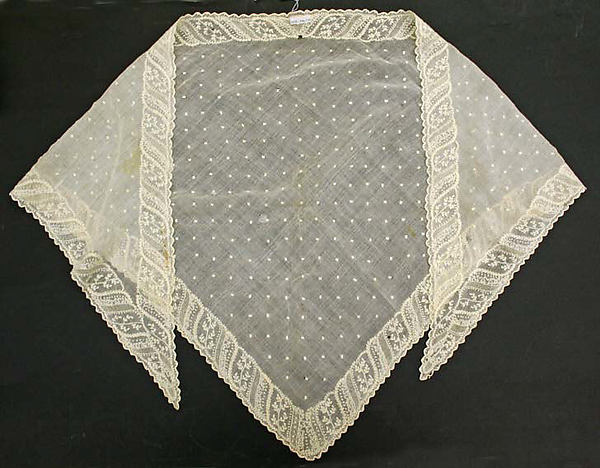Here are some examples of extant mitts:
Yellow Silk
Red Silk
Linen
Leather
Fancy Embroidered Linen
Fancy Embroidered Leather
I'm glad I did! The pattern has a bound booklet with instructions, photographs of all the construction steps along with photos of the extant pair of mitts the pattern is modeled after. It also contains in depth stitch guides. The instructions are very well written.
I traced the medium sized mitt piece to make a muslin. I didn't bother making the thumb pieces for the muslin. All three sizes of mitts use the same thumb piece. I then just machine stitched a 1/4 inch seam to check the fit. I ended up shortening the pattern 1 inch. Also, these mitts are cut on the bias which gives them a little bit of stretch.
I decided that I would make summer mitts from a piece of handkerchief linen leftover from a cap. I also decided to do the embroidery but to omit the wrist slit. The first thing I had to do was practice my embroidery stitches as it had been over 20 years since I last did this sort of thing. Fortunately there's a local shop called the Stitching Post that specializes in cross stitch and they had several brands of stranded silk floss. I settled on Soie d'alger 6 strand floss which they carry in over 100 colors. Since I like itty bitty needles, I bought some size 10 beading needles which are very thin with a larger eye to make threading easier. Using 1 strand of floss I practiced my herringbone and edge herringbone stitches.
I cut out the mitts and pressed the hem all the way around the edges. The directions say to press under 1/4 inch then turn under the hem allowance to make a 1/8 inch hem. I had trouble doing that with the fabric being cut on the bias so I just pressed under the 1/4 inch and left the edge raw. I used matching (white) silk sewing thread and stitched a running stitch all the way around to secure the hem. I made my running stitch about 1/8 inch from the folded edge. Making the running stitches an even distance from the fold helps in making you herringbone stitches even. Then, using one strand of floss, I stitched the three lines on the glove front and did the edge herringbone stitches around the edges as indicated in the pattern instructions. Because the gloves are cut on the bias, some stretching occurred during the stitching. I steamed them to flatten them back out before proceeding.
Finished stitching
Inside of glove edge stitching
I decided that I would do the double 1/8 inch hem on the thumb pieces as I thought they would get more wear. I pressed that hem under and then pressed under 1/4 inch on the curved edge that gets stitched to the glove body. I thought that pressing those first would make it easier. I then stitched a 1/4 inch side seam in the thumb piece. The instructions said to whip stitch the allowance but I did a felled seam that ended up being about 1/8 inch wide.
I used running stitch to secure the thumb hem and the seam allowance on the curved piece. The thumb hole was the trickiest part. I slightly snipped into the seam allowance and finger pressed it under about 1/4 inch, being careful to maintain the heart shape.
The thumb pieces butt to the glove piece. They do not over lap. I just whipped them together using tiny whipped stitches. The pattern is so well made that I did not have to pin. The pieces fit together perfectly.
Thumbs stitched on
Then the thumb seam is covered with herringbone stitches, being careful to cover the white running stitches.
Finished thumbs
According to the pattern, the point linings are stitched on using the edge herringbone stitch after pressing the hem allowance under. I decided not to do it quite that way as I didn't want to mess up the other side which also had herringbone. I did the edge herringbone stitches on the point lining piece, then laid it on the glove piece, wrong sides together. I used white silk thread and tiny whip stitches to stitch them together on the very edge. I secured the straight edge of the point lining to the glove with whip stitches --not the running stitches as indicated in the pattern.
All that is left to do is the ladder stitch which connects the side seam. I used 4 strands of floss for this and I spaced the stitches about 3/8 inch apart, based on the spacing of the edge stitches. I think next time I will make these stitches closer together.
Close up of stitching on back of hand
Close up of palm
Finished mitts
I'm so glad I decided to undertake this project. These will be perfect sun protection from the hot July 4 sun at Mt. Vernon!








































































